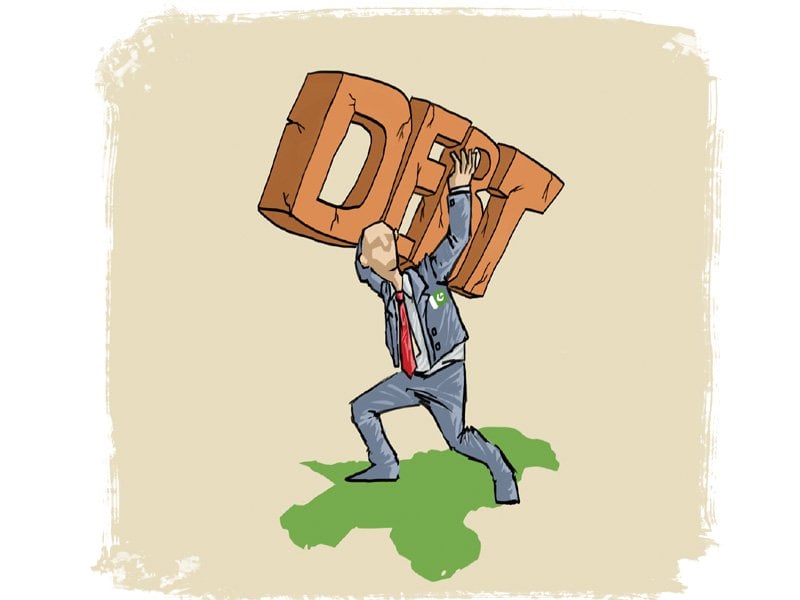
The public debt, which was at Rs24.2 trillion or 72.1% of gross domestic product (GDP) at the end of Pakistan Muslim League-Nawaz (PML-N) government’s term, would surge to Rs43.5 trillion or 70.1% of GDP by 2022-23, showed the figures that the Ministry of Finance shared with the National Assembly Standing Committee on Finance. There will be an increase of Rs19.3 trillion or 80% in the public debt during the five-year term as compared to the debt level left behind by the PML-N.
Although the public debt appears high at Rs43.5 trillion or 70.1% of GDP, the actual debt may even cross the projected threshold because the Ministry of Finance has used very conservative estimates of budget deficit and debt servicing cost. There could be at least 80% increase in public debt from fiscal year 2018-19 to 2022-23 despite the Ministry of Finance showing, on an average, only 2.7% increase in interest payments during the remaining four years of the government.
Over 31% addition to the public debt during the tenure of the PTI government has been projected on account of devaluation of the rupee against the US dollar. During its first year in power, an increase of roughly Rs3 trillion in public debt was because of currency devaluation but the total impact in remaining four years is projected at Rs3.02 trillion due to gradual adjustment in the exchange rate.
The standing committee did not discuss the debt projections due to the lack of availability of the same to the committee members. Prime Minister Imran Khan has remained critical of the Pakistan Peoples Party (PPP) and PML-N’s economic policies that, according to him, led to a huge increase in the country’s debt burden.
The finance ministry has largely based its projections on the framework agreed with the International Monetary Fund (IMF). However, it has not shown the IMF debt for balance of payments support as part of the official debt projections for the next four to five years.
In the first year of the PTI government, the federal government added Rs7.6 trillion to the public debt, which skyrocketed to Rs31.8 trillion by the end of June 2019. At the end of the PML-N’s term, Pakistan’s gross public debt was equal to 72.1% of GDP, which increased to 84% at the end of last fiscal year.
Reasons for increase in debt
The finance ministry has projected that the public debt would increase to Rs35.2 trillion at the end of current fiscal year - an addition of Rs4.2 trillion. Out of this, the increase of Rs3.2 trillion is projected because of the budget deficit and the remaining Rs1.1 trillion or 26% because of currency devaluation, according to the finance ministry projections.
In terms of size of the economy, the public debt is expected to reach 79.4% of GDP in 2020, which is slightly lower than the IMF projection.
For fiscal year 2020-21, the debt has been projected to grow to Rs38.6 trillion - an increase of Rs3.4 trillion at a pace of 9.6%. The impact of fiscal deficit is estimated at Rs2.6 trillion while the remaining impact will come from currency devaluation, estimated at Rs717 billion or 21.5% of the additional debt. In terms of size of GDP, the finance ministry projected the public debt to grow to 76.8% by 2021.
However, the IMF and the Ministry of Finance have shown interest payments at Rs3.13 trillion - an addition of just Rs161 billion despite currency devaluation and a high interest rate.
For fiscal year 2021-22, the debt is projected to grow to Rs41.2 trillion with an addition of Rs2.6 trillion. The finance ministry presentation showed that Rs2-trillion increase will be because of budget deficit financing and remaining Rs582 billion or 22% because of currency devaluation.
The finance ministry has put the debt servicing cost at Rs3.24 trillion, showing an increase of Rs102 billion over the previous year. In terms of GDP size, the public debt has been estimated at 73.5%. The budget deficit has been projected at 3.7% of GDP in 2021-22.
For the last year of the PTI government, the public debt is projected to grow to Rs43.5 trillion or 70.1% of GDP with an addition of Rs2.24 trillion. The budget financing impact is estimated at Rs1.6 trillion or 2.6% of GDP and the remaining impact of Rs628 billion is because of currency devaluation.
The finance ministry has estimated the debt servicing cost at Rs3.3 trillion for fiscal year 2022-23, showing an increase of only Rs67 billion that seems unrealistic.
The 70.1% of GDP debt in 2022-23 is considered unsustainable according to the Fiscal Responsibility and Debt Limitation Act. Under the Act, Pakistan’s debt should not be more than 60% of GDP.
Published in The Express Tribune, October 4th, 2019.
Like Business on Facebook, follow @TribuneBiz on Twitter to stay informed and join in the conversation.
1672385156-0/Andrew-Tate-(1)1672385156-0-405x300.webp)
















COMMENTS
Comments are moderated and generally will be posted if they are on-topic and not abusive.
For more information, please see our Comments FAQ